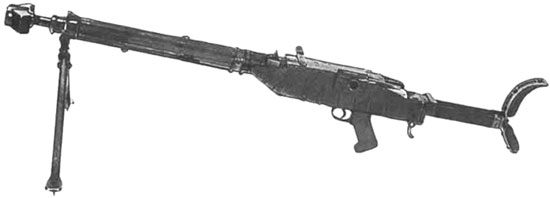BSW Model 1 anti-tank rifle

PTR BSW Model 1
In 1940, in order to replace the PzB 38 and PzB 39 single-shot anti-tank rifles (PTR) in service with the Wehrmacht for the Patrone 318 cartridge (metric designation 7.92x94), a competition was announced for the creation of new models of self-loading anti-tank rifles. German designers have developed a number of experimental self-loading anti-tank rifles with increased combat and operational characteristics, designed to use the Patrone 318 cartridge. Various arms companies presented the Model 40 (PzB 40 W), Model 41 (PzB 40 M), Model 42 (PzB 40 G), Model 43 (PzB 40 K) and Model 44 anti-tank rifles, the tactical and technical characteristics of which, despite the wide variation in design, were very similar.
| Caliber, mm | 15x96 |
|---|---|
| Length, mm | 1430 |
| Barrel length, mm | 838 |
| Weight without cartridges, kg | 15.0 |
In October 1940, thorough multilateral tests of new anti-tank rifles took place. However, by the time these trials began in the fall of 1940, some of the companies, relying on the experience of the French campaign, where the German infantry encountered tanks with armor up to 60-70 mm, had already begun to work on the creation of a new, more powerful weapon that could withstand the enemy’s promising armored vehicles. In this regard, the program to create an automatic anti-tank weapon for the 7.92-mm cartridge 318 was closed as unpromising, and the presented samples of guns remained in prototypes. The designers were asked to start work on more powerful anti-tank rifles.
In the autumn of 1941, on the basis of a new assignment for the design of the PzB 243 large-caliber anti-tank rifle, a number of prototypes of German anti-tank guns appeared, which used fairly effective 15x96 mm cartridges from the MG 151 large-caliber aircraft machine gun. The design teams of Gustloff, Krieghoff, Berlin-Suhler Waffen und Fahrzeugwerke (BSW) and SS-Waffenakademie took part in the competition.
BSW presented a prototype of a single-shot 15 mm anti-tank rifle, indexed “BSW Model 1”.
This gun was an enlarged version of the PzV 38 anti-tank rifle, but designed for a 15 mm caliber cartridge.
Like the PzV 38 anti-tank rifle, the BSW Model 1 was a single-shot mechanical weapon with a recoil barrel when fired.
The recoil device consisted of a spiral spring worn on the barrel.
The barrel was closed with a casing made by stamping.
Also, to reduce recoil, the barrel was equipped with a powerful muzzle brake.
The barrel bore was locked by a semi-automatic vertical wedge bolt. The bolt was reloaded with a trigger lever made in the form of a pistol fire control grip.
Hammer-type percussion mechanism.
The safety mechanism consisted of two safety devices: the first - flag-type was mounted on the right side of the receiver, the second - turned on when the buttstock was tilted down, which, in turn, reduced the dimensions of the weapon itself in the stowed position.

ASW Model 1
in stowed position
To reduce the dimensions of the gun in the stowed position and stability when firing, the weapon was equipped with folding bipods.
With a sufficiently powerful cartridge, this gun turned out to be quite compact and lightweight. With a weight of 15 kg, the BSW Model 1 anti-tank rifle had an overall length of 1430 mm, and a barrel length of 838 mm.
However, the appearance of powerful tanks in the early 1940s made the creation of large-caliber anti-tank anti-tank missiles unnecessary, since the traditional means of anti-tank defense of the infantry turned out to be inpowerful and no longer fully met the requirements of the time. By the end of 1941, the line of capabilities in armor penetration of 60-70 mm at ranges up to 100 m, reached by German anti-tank rifles, with a constant increase in the striking power of armored forces in the armies of the allies in the anti-Hitler coalition, left the Wehrmacht infantry practically unarmed in close combat, and the German anti-tank artillery of direct escort also did not keep up with the development of events at the front. Therefore, all work on the creation of 15-mm anti-tank weapons was stopped, and they remained, embodied only in prototypes.

BSW Model 1 anti-tank missiles
in combat position